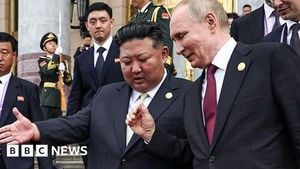As 2025 unfolds, the world finds itself at the crossroads of heightened geopolitical tension and mounting anxieties about the prospect of war. Headlines have been dominated by the specter of escalating conflicts in Eastern Europe, South Asia, and the Middle East. Yet, nowhere do the stakes feel higher than across the Taiwan Strait, where the possibility—however remote—of a Chinese invasion of Taiwan has become a focal point for politicians, defense analysts, and even mystics, who offer their own, sometimes chilling, predictions about what the year may bring.
According to The New York Post, the year has seen a convergence of warnings from both traditional security experts and renowned psychics. While the latter’s forecasts are speculative by nature, they reflect a broader sense of unease about the direction in which global affairs seem to be heading. Baba Vanga, the blind Bulgarian mystic famous for her eerily accurate prophecies, has reportedly foreseen a European war in 2025, describing it as a potential turning point for humanity. Nostradamus, whose cryptic verses have long been mined for clues to the future, is said to have predicted conflicts involving the United Kingdom and Europe, as well as the return of devastating plagues. These warnings, though unverifiable, have captured the public imagination, prompting debates about whether the world is truly prepared for such dramatic events.
But while the visions of mystics make for gripping headlines, the real-world analysis of a potential Taiwan conflict paints a far more complex—and ultimately less alarmist—picture. On March 29, 2025, U.S. Secretary of Defense Pete Hegseth issued interim National Defense Strategic Guidance that prioritized Taiwan as a central focus for American defense planning. This move, reported by The Washington Post, signaled the Trump administration’s intent to center its military posture around the perceived threat from the People’s Republic of China (P.R.C.). Many politicians, defense leaders, and industry commentators have since treated a Chinese invasion of Taiwan as a near inevitability, using the scenario to justify policy decisions and regular budget increases.
Yet, as detailed in a comprehensive analysis by the Stimson Center, the odds of such an invasion actually occurring are far lower than the prevailing narrative suggests. Four major factors stand in the way of a P.R.C. military campaign against Taiwan: the risk of nuclear escalation, the political dangers such a move would pose to the Chinese Communist Party (C.C.P.), the severe economic fallout that would result, and the sheer operational complexity of mounting the largest amphibious assault in history. Each of these considerations, on its own, constitutes a formidable deterrent; together, they make the prospect of war over Taiwan highly unlikely.
First and foremost, the risk of escalation cannot be overstated. Both China and the United States are nuclear powers, and any confrontation over Taiwan would carry the ever-present danger of spiraling into a nuclear exchange. As Brigadier General Greg Bowen remarked during a 2017 exercise simulating such a scenario, "It gets into a very difficult calculus. It’s clearly a place that we don’t want to go." This reality forces decision-makers in Beijing to weigh not just the immediate military challenge, but the existential risks to their country and the world.
Then there is the political gamble. The C.C.P. has long declared that reunification with Taiwan is a "sacred duty," enshrined in the P.R.C. constitution. Yet, a failed invasion—or even a costly victory—could fatally undermine the Party’s legitimacy. China’s population is aging and shrinking, a direct consequence of decades of the One-Child Policy. The youngest soldiers today are often the only children of their families, the sole heirs to multiple bloodlines. As the Stimson Center notes, "Casualties among such a population would have profound emotional, political, and economic consequences." Public sentiment in China has grown increasingly pacifist, with a University of California, San Diego survey revealing that economic concerns make citizens less likely to support war. Freedom House reported a 27% increase in dissent events from 2023 to 2024, most involving workers, property owners, and rural residents—evidence that economic well-being now outweighs ideological fervor for reunification.
The economic risks are equally daunting. China’s economy, once a juggernaut, has plateaued since 2021. Trade tensions with the U.S., the lingering impacts of COVID-19, and a real estate sector crash have all contributed to a more fragile outlook. In 2023, China exported $3.41 trillion in goods, making it the world’s largest exporter. A conflict in the Taiwan Strait would almost certainly disrupt global shipping, with knock-on effects for everything from high-tech industries to food security. The example of the 2021 Suez Canal blockage, which cost China an estimated $73 billion in GDP over just six days, offers a sobering preview of the potential fallout from a protracted regional war. International sanctions and embargoes would likely follow, further deepening the economic pain.
Operationally, the challenges are staggering. Taiwan’s geography is uniquely forbidding: its main island is ringed by rugged mountains, dense urban centers, and vast rice paddies that are ill-suited for armored vehicles. The Central Mountain Range covers nearly 60% of the land surface, and the terrain behind the few suitable landing beaches is either urban or marshy, complicating any breakout by invading forces. As naval historian Ian Toll observed, even at the height of American military power in World War II, U.S. planners ultimately abandoned their proposal to invade then-Japanese-held Formosa (now Taiwan), concluding that "the more they studied Formosa, the less they liked it." Today, the People’s Liberation Army (P.L.A.) would face an even more daunting task, with modern anti-ship missiles and drones poised to inflict heavy casualties on any invasion fleet before it ever reached shore.
Meanwhile, Taiwan has not been idle. Its military boasts 94,000 active-duty soldiers and 1.5 million reservists, with compulsory service recently extended to one year. The island’s defense preparations include annual Han Kuang exercises simulating a full-scale Chinese attack, as well as widespread civil defense training for ordinary citizens. As President Lai Ching-te stated during a civil defense drill in March, "We hope that through strength, not only of the military, but also the resilience of the entire society in defense, we can ensure Taiwan’s security and ensure that peace can be achieved through the demonstration of our strength." Recent polls indicate that two-thirds of Taiwanese would be willing to defend their island—a formidable obstacle for any would-be invader.
Internationally, the response to any Chinese aggression would likely be swift and broad. While the United States no longer has a formal mutual defense treaty with Taiwan, the 1979 Taiwan Relations Act obligates Washington to provide arms and maintain the capacity to resist coercion against the island. Regional allies such as Japan, South Korea, the Philippines, and Australia could also play significant roles in denying Beijing control of the seas. As the Red Sea crisis of 2023 demonstrated, threats to global shipping can prompt rapid, multinational military responses—an outcome Beijing would be keen to avoid.
Despite all the speculation—whether from defense planners or famed mystics like Baba Vanga and Nostradamus—the reality is that the greatest deterrents to war over Taiwan may come not from Washington or Taipei, but from within China itself. Economic vulnerabilities, public sentiment, demographic trends, and the sheer military challenge of an amphibious invasion combine to make such a scenario highly improbable. As 2025 continues, the world watches anxiously, but history, geography, and human decision-making all suggest that the path to war remains fraught with obstacles—and that peace, however precarious, is still the likelier outcome.




